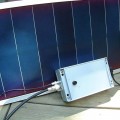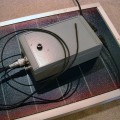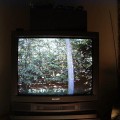
Siz ortalıkta yokken kuşların, geyiklerin veya ayının arkanızdaki “40” ında ne yaptığını hiç merak ettiniz mi? Sadece Uzaktan Gözlem İstasyonunu kurun ve vahşi yaşamı oturma odanızın rahatlığında TV’nizde izleyebilirsiniz! İstasyon, bir veya iki mil uzakta olabilen TV’nize bir resim gönderen bir kamera ve verici içerir. İstasyon, gücünü bir PV güneş panelinden ve yön için sistemin kontrol panosuna dayanan şarj edilebilir bir pilden alıyor.
Kontrol panosu ayrıca, TV’nize gönderilen resmin üzerine yerleştirdiği pil durumu bilgilerini de üretir. Böylece Bambi izlerken pilinizin durumunu da takip edebilirsiniz.
Ünite altı elektronik cihazı entegre eder: bir CCD video kamera, bir PV güneş paneli, bir şarj edilebilir pil, bir sıcaklık sensörü, bir RF video vericisi ve sistem kontrol panosu (PVCC). Kontrol panosu, Motorola’nın MC68HC908QY4 MCU’sunu temel alır ve bir PV şarj denetleyicisi, iki yüksek verimli voltaj regülatörü, bir video senkronizasyon ayırıcısı ve sistem yapılandırması için bir RS232 seri arabirimi sağlayarak sistemin merkezinde yer alır.
PVCC kontrol panosu, güç kaynağı olarak PV güneş panelini kullanan basit bir Açık/Kapalı akü şarj cihazı sağlar. Şarj kontrol cihazının birincil görevi, pilin aşırı şarj edilmesini önlemektir.
Kontrol kartı, video vericisine ulaşmadan önce CCD kamera tarafından üretilen video sinyaline bir metin yerleşimi (ekran üstü görüntü veya OSD) biçiminde pil durumu bilgilerini de ekler. Ek olarak, DB9 konnektörü aracılığıyla kontrol kartına bir PC bağlanabilir.
Sistemin üç çalışma modu vardır: kullanıcının kendi PC’si aracılığıyla davranışını ayarlamasına izin veren Yapılandırma Modu; kullanıcıya geri bildirim için pil voltajının ve sıcaklığının video sinyalinin üzerine yerleştirildiği OSD’li Şarj Kontrol Modu; ve kullanıcının teşhis ekranına ihtiyaç duymadığı durumlar için OSD’siz Şarj Kontrol Modu.
PVCC Yapılandırma Yardımcı Programı, Yapılandırma Modundayken PVCC kartıyla iletişim kurar. Bu yardımcı program ile kullanıcı, tam şarj ayar noktası (Off ayar noktası) ve PV yeniden bağlanma ayar noktası (Açık ayar noktası) dahil olmak üzere çeşitli seçenekler ayarlayabilir. Kullanıcı, bir HAM frekansı kullanılıyorsa, Amatör Telsiz çağrı işaretinin iletimini etkinleştirmeyi de seçebilir.
sistem görünümü
Uzaktan Gözlem İstasyonu, bir CCD video kamera, bir PV güneş paneli, bir şarj edilebilir pil, bir sıcaklık sensörü, bir RF video vericisi ve sistem kontrol panosu (PVCC) dahil olmak üzere altı elektronik cihazı entegre eder. Kontrol panosu, Motorola’nın MC68HC908QY4 MCU’sunu temel alır ve bir PV şarj denetleyicisi, iki yüksek verimli güç regülatörü, bir video senkronizasyon ayırıcısı ve bir RS232 seri arabirimi sağlayarak sistemin merkezinde yer alır.
Şekil 1, genel sistemin bir blok diyagramını göstermektedir. Fotoğraf 1, su geçirmez bir alüminyum kutu içinde bulunan Uzak Gözlem İstasyonunun kalbini göstermektedir. Yazar: Richard Dreher
Ever wonder what the birds, deer, or bear were doing in your back “40” when you weren’t around? Just set up the Remote Observation Station, and you can watch the wildlife on your TV in the comfort of your living room! The station includes a camera and transmitter that sends a picture to your TV, which can be up to a mile or two away. The station gets its power from a PV solar panel and a rechargeable battery, which rely upon the system’s control board for direction. The control board also produces battery state information, which it overlays on the picture sent to your TV. So, while you’re watching Bambi, you can also monitor the status of your battery.
The unit integrates six electronic devices including: a CCD video camera, a PV solar panel, a rechargeable battery, a temperature sensor, an RF video transmitter, and the system control board (PVCC). The control board is based on Motorola’s MC68HC908QY4 MCU and sits at the center of the system providing a PV charge controller, two high efficiency voltage regulators, a video sync separator, and an RS232 serial interface for system configuration.
The PVCC control board provides a simple On/Off battery charger using the PV solar panel as a power source. The primary job of the charge controller is to prevent the battery from being overcharged. The control board also adds battery state information in the form of a text overlay (on-screen display, or OSD) to the video signal generated by the CCD camera before it reaches the video transmitter. Additionally, a PC can be connected to the control board via the DB9 connector.
The system has three operating modes: the Configuration Mode, which allows the user to set up its behavior via their PC; the Charge Control Mode with OSD, where the battery’s voltage and temperature are overlaid on to the video signal for feedback to the user; and the Charge Control Mode without OSD, for when the user doesn’t need the diagnostic display. The PVCC Configuration Utility communicates with the PVCC board while in the Configuration Mode. With this utility, the user can set a variety of options, including the full charge set point (the Off set point) and the PV reconnect set point (the On set point). The user can also choose to enable the transmission of an Amateur Radio call-sign if a HAM frequency is being used.
System Overview
The Remote Observation Station integrates six electronic devices including: a CCD video camera, a PV solar panel, a rechargeable battery, a temperature sensor, an RF video transmitter, and the system control board (PVCC). The control board is based on Motorola’s MC68HC908QY4 MCU and sits at the center of the system providing a PV charge controller, two high efficiency power regulators, a video sync separator, and an RS232 serial interface. Figure 1 shows a block diagram of the overall system. Photograph 1 shows the heart of the Remote Observation Station, enclosed in a water-tight aluminum box. Author: Richard Dreher
Şifre-Pass: 320volt.com
Yayım tarihi: 2012/07/07 Etiketler: mc68hc908qy4, observation station, pv charge, pvcc control






